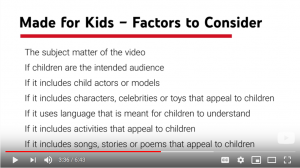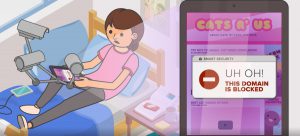MythBusters: COPPA Edition
Following YouTube’s September settlement with the Federal Trade Commission (FTC) regarding the Children’s Online Privacy Protection Act (COPPA), YouTube released a video in late November explaining upcoming changes to their platform. The YouTube creator community responded in large numbers, with numerous explainer videos and almost two hundred thousand comments filed in response to the FTC’s just-closed call for comments on the COPPA rule. Some responses have been insightful and sophisticated. Others have indicated confusion and misunderstanding of COPPA’s requirements and scope. This blog addresses some of the most common myths circulating in YouTube videos, tweets, and Instagram posts.
Fact 1: You can’t “stop COPPA” by filing comments with the FTC
Some COPPA explainer videos call for viewers to write comments to the FTC asking them to “stop COPPA.” There are two problems with this call to action.
- First, the FTC can’t stop COPPA. COPPA is a federal law, passed by Congress in 1998. The law has existed for over 20 years, and the FTC does not have the authority to get rid of COPPA. Asking the FTC to do something beyond its authority will not change the law, YouTube’s policies, or the rules that creators must follow.
- Second, the FTC is reviewing the rules it created in 2013 to determine whether they need to be updated or changed. These rules describe how the FTC implements and enforces COPPA. This is an important opportunity for creators to be involved in how COPPA will shape internet video services – it’s crucial to know what comments can accomplish. Comments to the FTC will influence how the rules will be implemented and enforced in the future but are unlikely to change things that have already occurred, like the YouTube settlement.
The recent changes to YouTube occurred because the platform agreed to modify some of its practices (and pay a fine) rather than go to court against the FTC. The major change for creators involves the addition of the “made for kids” flag: all creators are required to select whether their channel or a specific video is created for kids or for a more general audience. The flag tells YouTube when they can and cannot place targeted advertising (which isn’t allowed for kids under COPPA). The settlement did not require the creation of an algorithm to look for misflagged content or the changes in viewer functionality for “made for kids” videos. YouTube did this, and the FTC can’t change the platform back to the way it was.
That doesn’t mean that creators shouldn’t engage with the FTC. The current FTC comment period will be over, but the process of creating new COPPA rules will likely take years, and there will be more opportunities to be heard. The FTC needs to know which data creators have about their users and how that data drives decision-making. Tell them about your income from advertisements, your level of control over the advertisements on your channel, and what you wish you knew about advertising on YouTube. The FTC needs to understand your business model and the business of content creators on platforms in general. So, tell them about how information from YouTube informs the content on your Twitch stream, whether it changes how you use your Patreon, or influences merchandising decisions. The best way to get useful rules that protect children’s privacy while supporting content creation on the internet is if the FTC knows how this portion of the economy works.
A note about commenting: be polite. When you make comments on a government website, a real person will read them. So don’t use all caps or profanity, and write in complete sentences. The point is not to fight the FTC but to inform them of your concerns. While asking your viewers to comment can be useful, make sure that you remind them to be kind as well. Civil, smart comments are more likely to have a positive influence.
Fact 2: COPPA is not infringing on First Amendment rights
COPPA regulates the collection, use, and sharing of data created by children. COPPA does have specific obligations for data collected from websites or online services directed to children, but those obligations do not dictate the content you can or cannot create. COPPA may make it more difficult to profit from child-directed content, but this does not mean that anyone’s rights have been infringed. YouTube’s Terms of Service and platform design have more influence than any American law over the kind of content users can create.
Fact 3: Not everything is child-directed
YouTube’s video explaining COPPA-related changes to the platform includes a list of factors that can indicate whether a video or channel is made for kids.
This has caused some confusion. Just because a channel or video may check one or two of these boxes does not mean that it is child-directed. The FTC said as much in its blog post (if you have not read it yet, please do). The blog was written specifically to answer questions about what constitutes “child-directed” content.
If you’re still confused about whether your content is child-directed, ask yourself, “Who am I speaking to?” When you create a video, you should have an idea of who will watch it. And humans use different communication strategies for different kinds of people. For example, think about sitcoms created for major TV networks like CBS, NBC, or ABC versus sitcoms created for the Disney Channel or Nickelodeon. While the two types share similarities, including the format, some of the situations, and the presence of a laugh track, there are major differences that reflect the different audiences. Some sitcoms created for children have simpler language, vivid costumes, or include extensive over-acting (for a visual explanation, watch this clip from SNL). These features make the content more engaging for children. Think about your content. Where does it belong: the Disney Channel or ABC?
After you decide whether your channel or individual video is made for kids, write down why you made that decision. There are two reasons for doing this. First, if the FTC contacts you or if YouTube changes the flag on your video, you will have already prepared your response. You won’t have to try to create responses based on decisions you may have made months or even years earlier. Second, and more importantly, this will keep your actions consistent. As you continue to work and create new videos, you may not remember why you said one video was made for kids while another wasn’t. This not only creates a record of your decision-making process but should make it easier in the long run.
Fact 4: A COPPA violation probably won’t bankrupt your channel
The FTC has stated that when it determines fines for violations, it considers “a company’s financial condition and the impact a penalty could have on its ability to stay in business.” The FTC’s mission is not to put people out of business but to protect consumers. They have limited staff and limited resources; targeting small channels or channels about which a reasonable person could disagree whether the content is child-directed is not typically a good use of their time. But this does not excuse creators from reviewing videos and flagging content as appropriate. You must comply with COPPA, but if you make a mistake, the FTC’s likely first action would be to ask you to change your flag, rather than impose a large fine.
A final piece of advice: do not panic. Panic won’t help. Take a deep breath, review your channel, and stay informed about any other changes that YouTube may announce.




